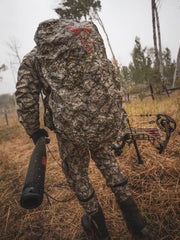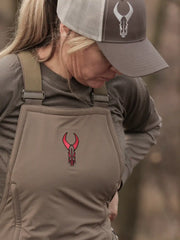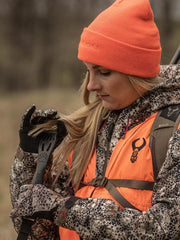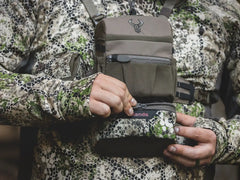Good layering is the key to comfortable hunting

Hunting is kind of like an onion.
It can be sweet. It can be bitter. At times, it can even be pickled (afterwards).
But smart hunters also know the key to comfortable hunting is to layer like an onion.
Sure, you may look out the window and see the wind, sleet and… was that a cow?... and think that the biggest, warmest bib/parka combo is the key, but you are mistaken.
Yes, it’s toasty warm at first. But after a little hike with a pack and rifle it becomes stiflingly hot. So, you get to your stand or glassing point and figure, I’ll just unzip a bit and be fine. Except then all that sweat starts to chill and suck all the heat from your body.
No bueno, my friends.
Going light isn’t really the answer either, as you’ll be great when it comes time to lug a freezer’s worth of protein out, but you’ll be a human meatsicle until then.
The answer, my friend, to not shivering in the wind… The answer is layering from outside in.
The Base Layer
Gone are the days of slapping on your granddad’s old thermals and heading out. For one, eyyeewww…. Used undies. Two, they just aren’t that good.
Sure, the classic thermal held in heat, but it also held in moisture and as anyone who’s been cold AND wet will tell you, that’s a potentially lethal combination.
Modern base layers will be moisture wicking to quickly pull that perspiration away from the body and out into the atmosphere. This does two things that help the hunter. For starters, it actually helps cool, as that evaporating sweat is what cools the body (and why swamp critter hunting in Florida in July is hell on earth). Secondly, it gets that moisture off the body, so when you do cool down you don’t experience a runaway of heat loss.
When it comes to materials, the two best options are Merino wool or synthetic technical fabrics, and naturally we’ve got you covered with both.
Merino is a natural fiber and is the bomb at pulling moisture away and controlling scent (for both the critters and your hunting pals). The one downside is Merino takes a bit longer to dry out.
Synthetics, on the other hand, dry lightning fast and usually hold up to rough use a bit better but aren’t quite as effective as Merino.
For the best of both worlds, check out our items with DuraSpun Merino. This takes the best that Merino has to offer and weaves in just enough synthetic to toughen it up.
The Mid Layer
This is the workhorse of the layers. The mid layer is the defense-minded point guard who can shoot and pass the ball. A five-tool player. The Swiss Army knife of clothing.
Key terms here are moisture wicking, insulation in the right places, breathability in others. This may become the outer layer when the work gets hard or the day gets warm, but it’s also the comfort bringer when it’s chilly. It keeps warmth in and wet out.
In our sandwich metaphor, the mid layer is the mayo, and we all know mayo is the hardest working of the condiments. Finding the right mixture of utility as an outer and warming/drying as an under layer is key.
The Outer Layer
 This is the armor. The burr fighter. The wind blocker. The water repellant. You pick this piece based on the worst-case scenario. But just as medieval knights didn’t just wear a suit of armor and call it a day, you need to consider this the first line of defense against the slings and arrows of mother nature.
This is the armor. The burr fighter. The wind blocker. The water repellant. You pick this piece based on the worst-case scenario. But just as medieval knights didn’t just wear a suit of armor and call it a day, you need to consider this the first line of defense against the slings and arrows of mother nature.
Wind proof, water resistant, and grams of insulation are some of the key components to look for here. But don’t forget articulation, storage and comfort. This is the biggest piece by size, usually, so make sure it’s the right fit (literally and figuratively).
You can technically go with whatever color but seeing as we’re hardcore hunters and prepare for anything, we make them in Approach and Approach FX, along with solids.
Why?
We’ve been on hunts where the wind dies out and the sun pops up and we’ve had to pare down to our base layer to keep us in the hunt. Also, this one time we [content redacted] and our base layers were all that kept us out of jail. (What happens at deer camp stays at deer camp.)
Now that you have the lowdown on keeping warm and cool in the down lows, the strategy for using the layers is pretty basic.
If you’re hot, take a layer off. Start with the outer layer… Do we really need to say that? We do? OK. Start with the outer layer and see if that makes you comfortable. If not, keep going.
If you’re cold, add a layer. See? Not rocket science, is it?
And if you’re wondering what to do with an outer layer once it comes off, we suggest looking over your shoulder. See that sweet Badlands pack you’re wearing? Not to dumb it down too much, but that makes a great layering storage system.
So, friends, as you can see, if you think like an onion and build your gear around layers, there will be no reason to cry.
Here’s a few suggested pairings, depending on what and where you may be hunting.
Big Game Hunting
| MEN | WOMEN | ||||||||||
|---|---|---|---|---|---|---|---|---|---|---|---|
| OUTER | Calor Jacket + Pant | Calor Jacket + Pant | |||||||||
| MID | H.U.2 Vest | Flex 1/2-Zip | |||||||||
|
BASE
|
Pecora Crew + Legging | Pecora Crew + Legging | |||||||||
Whitetail Hunting
| MEN | WOMEN | ||||||||||
|---|---|---|---|---|---|---|---|---|---|---|---|
| OUTER | Silens Jacket + Bib | Pyre Jacket + Bib | |||||||||
| MID | Flex 1/2-Zip | Detour Hoodie | |||||||||
|
BASE
|
Source 1/4 Zip + Legging | Lagatha Legging | |||||||||
Hopefully this helps you get started on building a smart, layered approach to your hunting apparel.
Still not sure how to build out your layers? Good thing you know where to visit on the World Wide Web to find all the Badlands goodies, from base layer to outerwear. Give us a shout and we’ll help you figure out the right approach to keeping your onion warm and dry this season.















